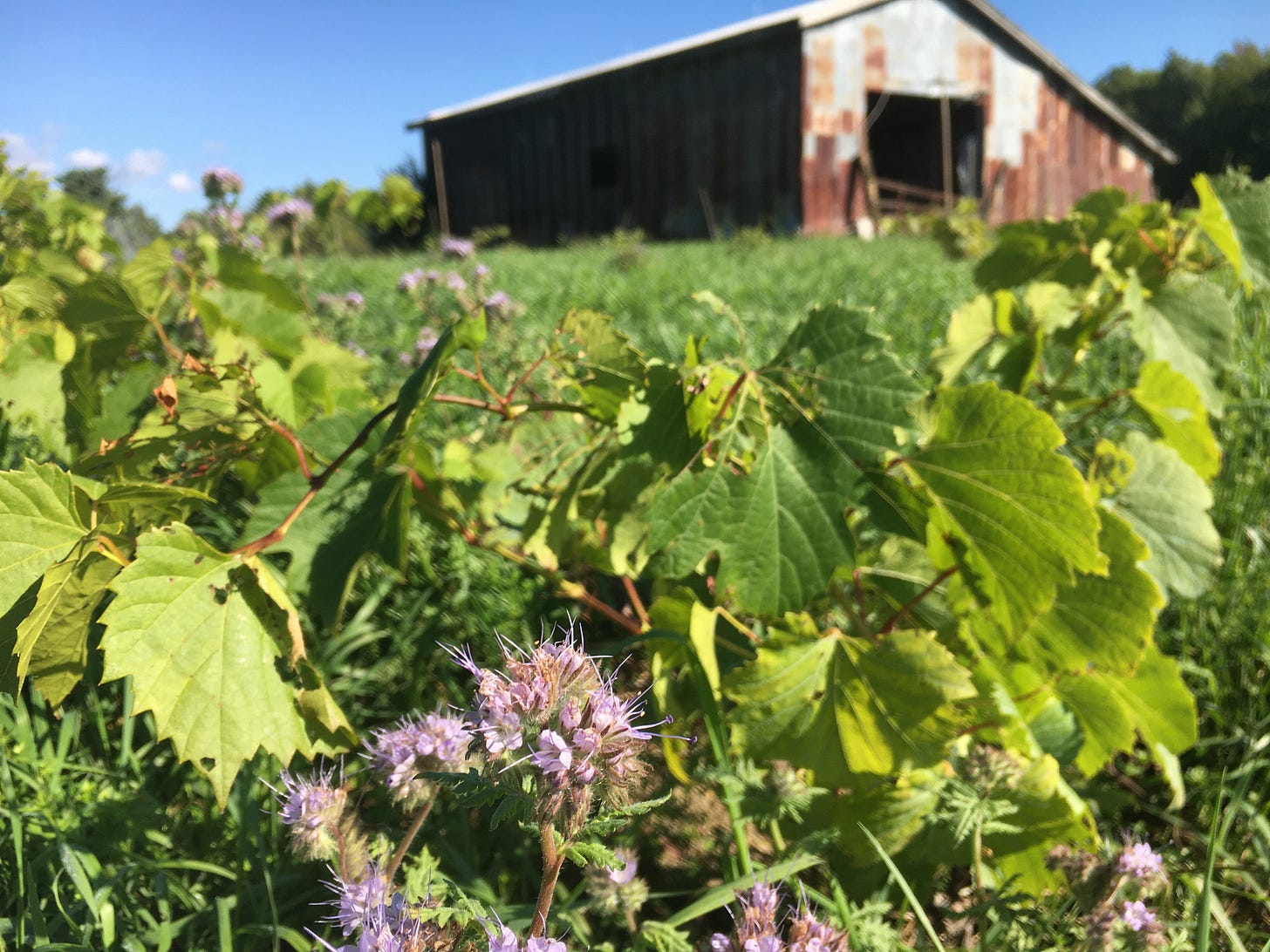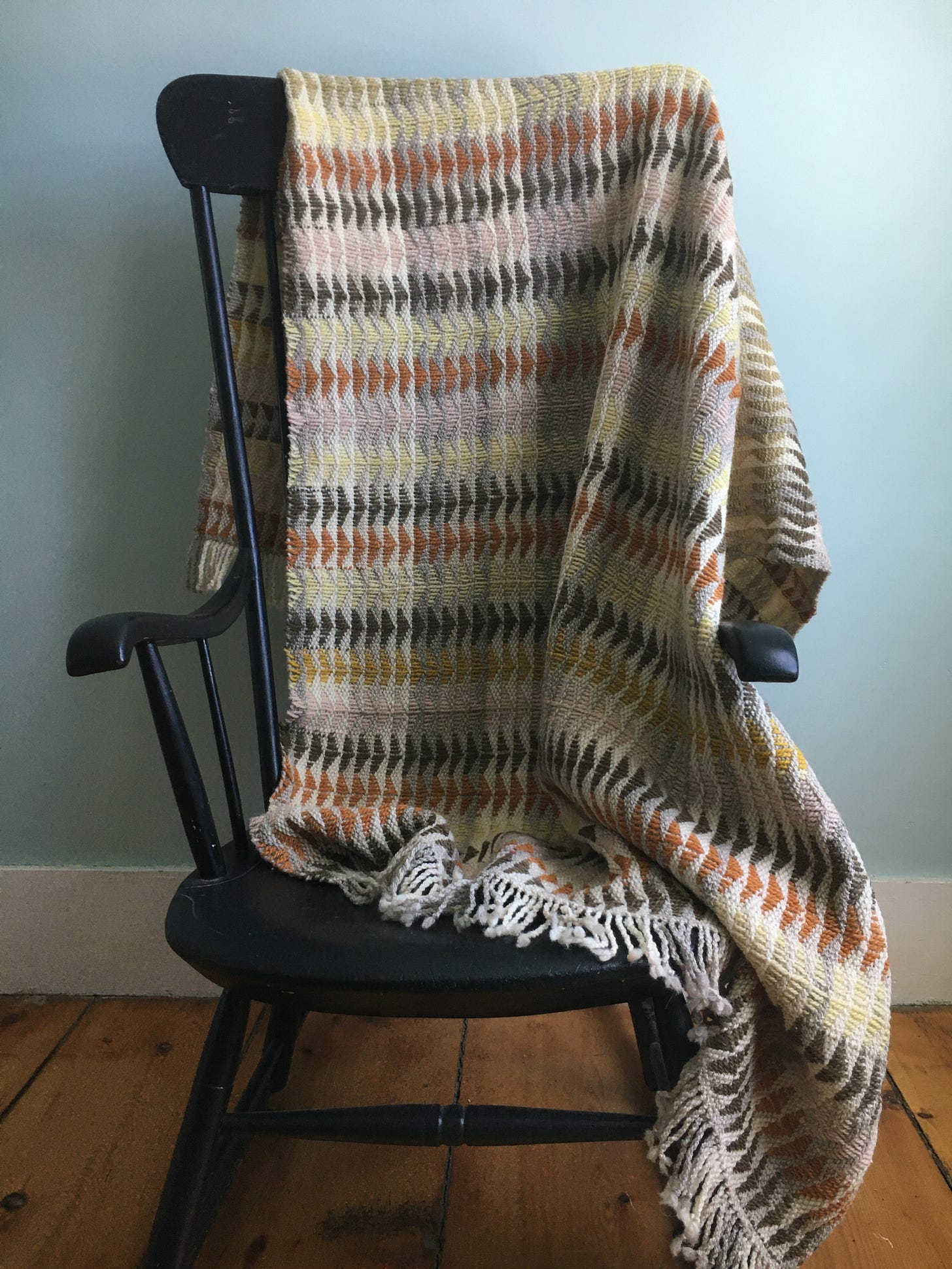Winter 2022 Newsletter
Hello!
Thank you for signing up for our newsletter—we are hoping to share updates seasonally about the farm and sheep, and what we’ve been weaving. Please feel free to forward and share this email with anyone who you think would be interested in our farm or interested in the textiles we are making.
In the spring of last year, Taylor and I began the process of purchasing a home and 60 acres together. The opportunity came up unexpectedly after we had been searching the area for the last two years for a place to make our own. In that search process we looked at many different properties—some large, some small, some with a house, some without, some for sale, and most not. On our first visit to what is now our home, I was completely unprepared for what we encountered. We came into the situation kind of thinking it was just going to be a formality to look around the place and cross it off the list. However, after walking around the land for not even 10 minutes, we looked at each other and realized we were both thinking the same thing: This was the most exciting property we had come across yet. From the road you see a proud farmhouse with a large wrap-around porch that sits a bit up above the road. The land climbs behind the house and wraps around in large hay fields to the back and side. There is a rather run-down barn tucked behind the house, and a larger open structured pole barn at the very top of the hill by the hayfields. Down from that top barn is the skeleton of an old windmill with a cistern below, which we believe fed water to the lower barn. There are large rock outcroppings throughout the fields, and on the large slope behind the house is the start of an orchard—apples, pears, plums and even a peach tree. In short, it is a dynamic property that is of a scale that feels like the two of us, in addition to some sheep, can manage it. With the added bonus of a characterful farm house from 1835 in relatively good shape, and a price that was within our budget and felt reasonable, it was an easy decision to go for it. Fast forward four months, all the lawyers and bankers had signed off on everything, and we got to move in at the beginning of August.
The fall felt like a whirlwind, because we were in the midst of our catering season with our jobs at Echo Farm (https://www.farmsteadcatering.com/). However in those first few months we cleaned and repainted the interior of the house, fixed the roof of the woodshed and bucked and split enough firewood to get us through this first winter. We officially started our farm business, which we decided to call Wollecru (voh-leh-crew) which is a made-up word. The name is a portmanteau of the German word for wool and a French wine making term that means crop, harvest, or growth. Linguistically it mirrors our two surnames, and in meaning it ties together the two main enterprises we were excited about for the property. My growing interest and practice in sheep and fiber is mirrored by Taylor’s interest in viticulture and winemaking. Before the sheep even came to this property, we spent a weekend in May planting 65 wine grape vines on the hillside up from the future sheep barn. We have another 30 odd vines growing at Echo Farm, which we are thinking about moving to our property, and have more vines ordered to arrive this coming spring. Although it will be a few years before we can make wine from our own Wollecru grapes, we have been learning about wine making by harvesting a crop each fall from a vineyard in Reber, as well as foraging for wild apples around Essex and Westport. Our method would broadly be called “low intervention” or “natural,” as in crush the grapes, and add nothing else. Luckily our farmhouse also came with a beautiful field stone basement, in which at some point someone poured a concrete floor. Along with holding our furnace and water system, this will be the wine cellar.
We see a lot of parallels between raising fiber and farming wine. Each product is an expression of one year’s worth of growth. Each shearing harvests the fiber that has grown through one year’s worth of sunshine and hail storms, foggy days and hot summer nights. If the sheep were fat and happy the wool is long and lustrous, buttery and soft. Similarly, each season’s grape harvest will reflect the growing conditions of that season. If it was dry and hot the grapes will be small and concentrated, if it was a wet year the grapes may be bursting with liquid and the resulting wine will be quite different.
We got the batches of mill spun wool that I sheared in the spring of 2021 back from Battenkill Fibers in September and November. I began by doing a few dye days, to get some beautiful colors to mix in with the natural tones of white, grey and oatmeal that came right from the sheep. Dyeing itself could be a whole newsletter, but I began by making a dark olive green from sheep sorrel mordanted with iron, and kind of a mellow orangey/gold which came from dried coreopsis flowers that I grew at Echo Farm over the summer. On the next dye day, I used avocado pits and skins to get a light pink, and both yellow and red onion skins to get a range of greens and golds. I also did an indigo dye day, with lump indigo that I processed back in 2019 from a big harvest of Japanese indigo—some of which I grew at Echo Farm, but most of which I picked over in Vermont from a farm in Cabot that had grown 600 row feet of indigo and didn’t know what to do with it. I drove over with Taylor’s pickup and filled the whole bed with indigo plants, not really knowing myself what to do with it all. Luckily, I found a very thorough blog about processing the raw plant into stable lump indigo. Each time I dye a batch of wool I only need a few tablespoons at the most, so my supply will last a few more years at least.
In my fantasy I pictured that I would be whipping through the wool, weaving large blankets all winter, however I failed to remember that a huge component of weaving, when one is weaving one’s own creations, is sampling. Sampling means weaving swatches, large enough to really get a sense of the drape and squish of the fabric, so that a larger project can be designed around that. The structure of weave on the loom will react differently when the fabric is taken off, and taken out of tension, so all different projects, ideas, and inspirations need to be tested before committing the time, effort and most especially the wool to a batch of items. But sampling takes time, and also precious wool! Often they don’t work out as planned, and you need to make a tweak, weave another sample, and go from there. This meant that over the course of the last three months, a large amount of time was dedicated to research, planning, sampling, tweaking, as well as actually sitting down and hammering out a few inches per day of weaving. One pattern I landed upon was what I’m calling “flying geese,” as it mimics a very popular quilting pattern of the same name. It is made of repetitive triangles, in much the same way geese fly in Vs across the autumn skies. I striped groupings of the dyed colors across neutral colored warps (that are also subtly striped) to make these lines of triangles. The structure itself is a type of overshot, where you weave with two shuttles of weft thread, in my case one neutral colored background pick alternated with one dyed pattern pick, so that the fabric is sturdy and plush with a bold, graphic pattern.
Throughout the winter I mostly wove for an hour or two in the mornings, while it was still dark before we left for work. In those early morning hours, I felt my brain was alert and creative enough to work through the challenges of weaving, and it felt really good to be productive early in the day and then cut myself some slack when we’d come home cold and exhausted from work. Once the sun poked up over the horizon, we’d dress ourselves for the cold and start the car. Then we’d pop into the barn to feed our barn cat, Skimbleshanks, and go pull our Vermont cart up to the top barn where all of our hay is stored, packaged in huge 5 foot wide round bales. Whichever one we’re feeding from at the moment is turned up on end like a little tower, and I can split a layer off the outside and as I walk around the bale unraveling the layer, twist it back on itself so that it creates a tight littler roll of hay that I then swing up on my shoulder and plop into the cart. This winter we have ten sheep to feed, so two rolls in the morning and another few before dark is enough for them.
This winter we have learned where we need to plant trees for windbreaks, as this property is quite exposed to the south and we’ve had some wicked winter storms blow through. The sheep luckily haven’t seemed to mind so much, they are usually laying down in their sunny pole shed, chewing their cud in their 5 inch thick coats. Although there is much cold weather still to come, the end of winter for us is coming soon. At the beginning of March the sheep are getting shorn, and after I pick through the fleeces I will bring them down to Battenkill Fibers again to be spun into another batch of yarn. Just a few weeks after that we should start seeing lambs, this year 4 of my oldest ewes are pregnant, so ideally we’ll have 8 lambs by April. And even though temps will still get low, the days are notably longer—Persephone has returned, along with robins and the resident barn pigeons, who made their entrance on February 17th. The lilacs and crab apples and grapes are pruned, more trees and shrubs and vines are ordered to arrive later in the spring. I have a bag of black currant and gooseberry cuttings in the fridge healing over, which we will stick into nursery beds to propagate soon, and I’ve begun seeding some perennial flower seeds that I will grow on as we build the gardens here at Wollecru.
That just about brings you up to date! I’ve attached a document with all the textiles we have for sale now, please peruse and share with anyone who you think might like to buy something from us. In about a week anything that is not sold I will list for sale on our Etsy shop, however the prices will be a bit higher to account for the commission that Etsy takes, so I would recommend buying directly from us now. For shorter pictorial updates you can follow me on Instagram (@kirstenliebl) and look out for our spring update in a few months, to hear about lambing.
All the best,
Kirsten and Taylor







